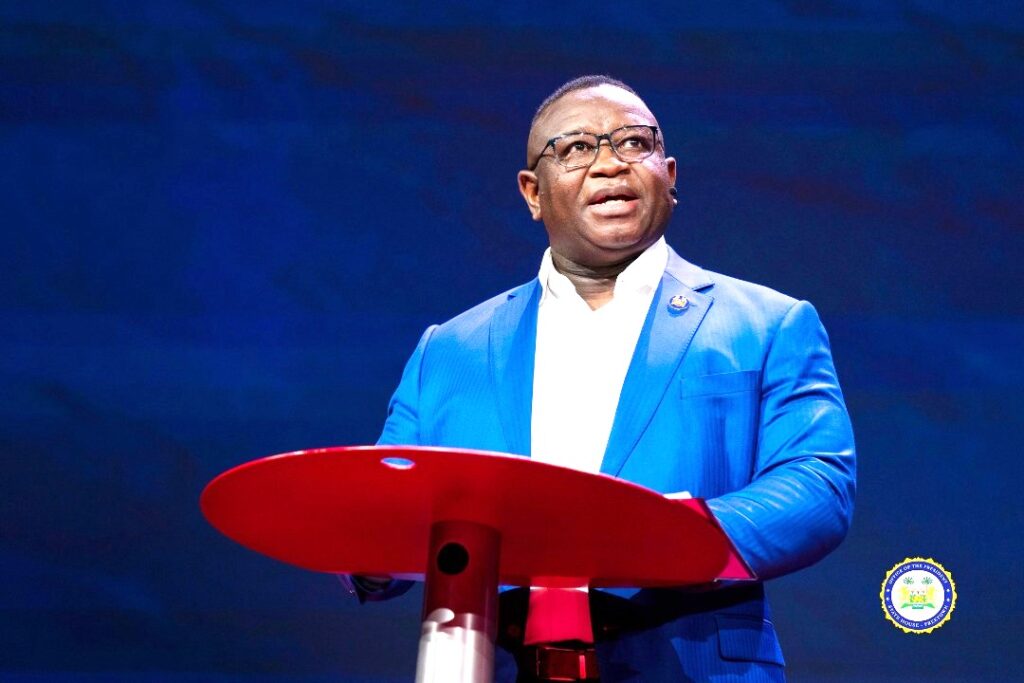Sierra Leone’s first ever Directorate for Science, Technology and Innovation (DSTI) in Africa, has championed President Bio’s vision to make Sierra Leone a nation that is driven by innovation and technology.
Government has worked to establish structures: midwife at the Office of the President that will be used by MDAs and other critical institutions to inform critical decision making processes in health, communication, agriculture, education and other emerging issues.
President Bio is expected to officially launch the National Digital and Innovation Strategy (NIDS) on the 1st November, 2019.
The move by President Bio is expected to boost and quicken Sierra Leone’s human capital development.
The Department for Science, Technology and Innovation which celebrated its first anniversary this week, is the lead agency charged with providing the technical know-how for Sierra Leone’s innovation and technological transformation over the next 3 to 10 years.
The foundation for digitization under NIDS comes after eight months of consultation with government, civil society leaders, donors, international actors and citizens.
A delegation from Sierra Leone also with a view to inculcate best practice into the innovation journey took a learning tour to Estonia, a country which remains one of the most recognized global leaders for state-led digitization and e-governance.
President Bio in several engagements with key innovation specialists and key MDAs, has noted that his engagement with innovators, technologists from MIT, TED and at the DSTI has taught him that if Sierra Leoneans are open to exploring new ideas and do things innovatively, they will not only gain a better understanding of our development challenges but also the emerging challenges affecting the citizens.
Sierra Leone with a population of a little over 7 million has 57% of its population living in poverty.
The country is ranked 184 out of 188 countries in the United Nations 2018 Human Development Index.
Other countries with the same GDP per capita rank better on the HCD Index.
Over 55% of households in Sierra Leone own mobile phones, and it is this fact that makes digitization plausible.
Citizens can already access a DSTI Integrated Geographical Information System (IGIS) to retrieve information about public service infrastructure.
With the iGIS Portal, citizens can use Unstructured Supplementary Service Data (USSD) to send an SMS to the short code *468# to locate government services-‘find my nearest school,’ ‘hospital,’ or ‘local court,’ saving time and in cases of emergency facilitating life-saving interventions.
Sierra Leone is embracing digitization and the President has sounded a clarion call that no citizen is left behind.
It is hoped to have every national own a digital ID. All government employees, ministries, departments and agencies, and national assets will also be digitized, so also will be banking and financial services.
As of August, Sierra Leone became the first country to deploy a blockchain digital ID platform to make financial services accessible to the unbanked.
With NIDS, the government will better understand when, how and where to provide services, and more importantly, which services will deliver the most impact towards the HCD.
For the vision to become a reality, the government’s leaders must embrace the change, says Dr. David Sengeh, Chief Innovation Officer.
One government agency that is already leading the way in terms of imbibing the change is Statistics SL – the agency that collects, stores and analyzes demographic data to inform decision making.
NIDS enables researchers at Statistics to launch a Comprehensive Health and Epidemiological Surveillance System (CHESS)-a longitudinal study that will follow participants throughout their life.
CHESS relies on e-ID to link data from health facilities to community-level information.
“We struggled to create the electronic identification system in other countries like Ghana, Kenya, Uganda, Burkina Faso, India and Vietnam where we implemented CHESS for research,” said
Sierra Leone’s Statistician-General, Professor Mallam O. Sankoh, a global expert on development research and data for decision making.
Sierra Leone’s government aims to be fully underway on its digitization journey by 2023.
Over five million citizens already have a digital ID that unlocks with their thumbprint.
DSTI has developed a fleet management system that tracks and manages government vehicles to stop the kind of loss that occurred in 2018 when thousands of cars belonging to the state went missing.
25-year-old Jane Williams from Cole Farm, who works at a local media company, said that to her digitization matters because of accountability.
“This will also give citizens peace of mind knowing we can use digital data to monitor officials in terms of corruption,” said Williams at Bintumani Conference Centre after the launch of NIDS.
“Sierra Leone doesn’t lead in many things, but today with DSTI and the launch of NIDS, we can say we lead with technology for development.”
New Direction Positions Sierra Leone
